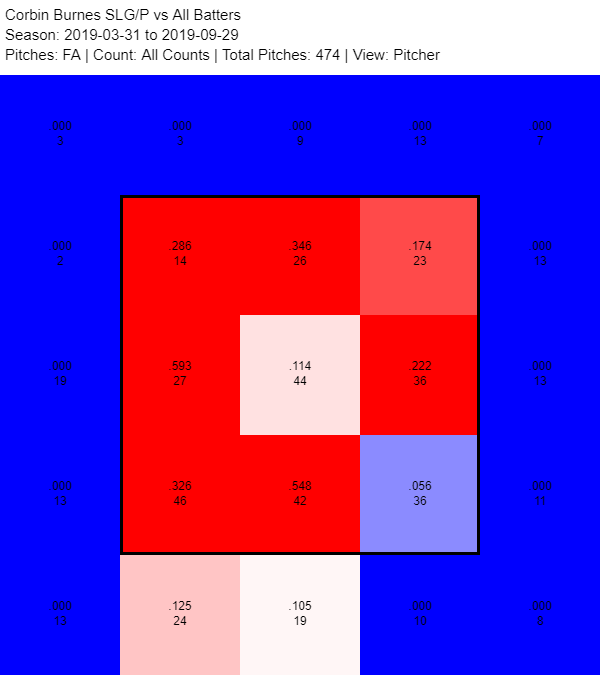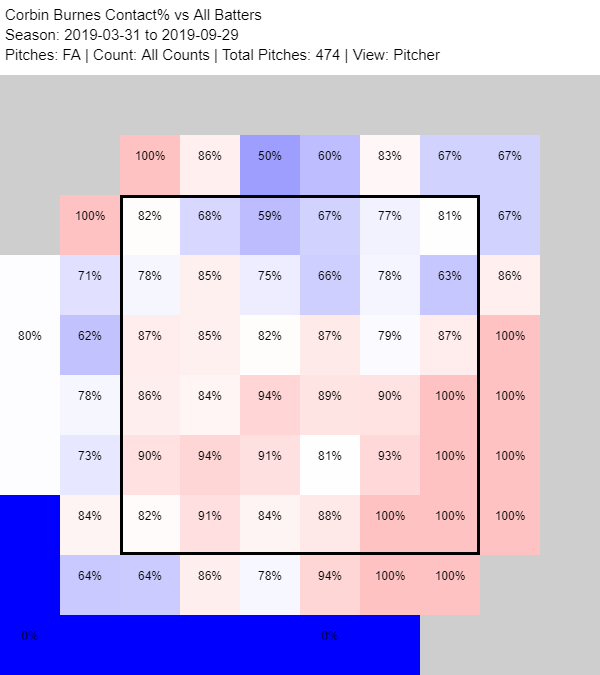I’m quite fond of Corbin Burnes. I like him so much so that I felt more favorably about him than his teammate Brandon Woodruff. Of course, that turned out to be aggressively wrong. At least for now. Woodruff posted a 3.3 WAR and a 3.62 ERA season in 121.2 innings, while Burnes had a poor showing in 2019, bopping around between Triple-A and the majors. Some of his peripherals were rather strong, but by outcomes, he had a rough year. So why do I think a pitcher with an ERA just south of 9.00 might be on the verge of the breakout? This is why:
Corbin Burnes is dealing, folks. 12 up, 12 down, seven strikeouts. Fastball up to 98 mph. He looks fantastic.
— Tom (@Haudricourt) July 16, 2020
If you’ll remember, Burnes’ fastball got touched up badly in 2019. The list of pitchers with a worse fastball by pVAL is short: Jhoulys Chacin, Adrian Sampson, Jakob Junis, Dylan Bundy, and Mike Leake. The frustrating thing is that his fastball should be significantly better than theirs. As a starter, Burnes throws 94.5 mph. Chacin? 90.0. Sampson? 92.2. Junis? 91.7. Bundy? 91.1. Leake? 88.6! Their fastballs are bad, but Burnes’ doesn’t have to be.
At this point, this is a well-worn topic, but Burnes’ fastball’s spin axis is really poor. Ray Butler has written about it, and several others have talked about it. What does that mean? It means that his fastball is straight as an arrow (and sometimes gets cutting action), for one. By active spin, Burnes’ 59.8% on his fastball ranks in the 10th percentile in the league, so instead of having one of those “rising” fastballs that defies gravity, his fastball gets more sinking action. That’s a shame, because his 2659 rpm raw spin rate on his fastball ranks in the 100th percentile in the Statcast era for starting pitchers.
One thing with his fastball’s spin axis is that he cuts it, which probably makes for more inconsistent command of it, and another is that his fastball is easier to hit because it’s so straight and heavy. This has obviously been an awful combination, but it’s nothing that can’t be ameliorated. And we know Burnes is trying to improve his active spin (or spin efficiency, if you prefer that verbiage). If he can improve it even a smidge, that would serve his fastball well. The difference between his current 59.8% and, say, 70%, would get him to Lance Lynn or Jack Flaherty territory and would have huge ramifications for the movement of his fastball. For now, it seems like he may have done that:
https://twitter.com/baseball7310/status/1283550147025264645?s=20
This is a considerable development, and it helps explain how Burnes dominated a Brewers lineup that isn’t too shabby. Citing another tweet, there’s another change that Burnes may be undergoing that should help him out too:
https://twitter.com/baseball7310/status/1283554968696479745?s=20
This is just one tweet about one pitch, but it’s encouraging to see that not only is Burnes going to his fastball as an out pitch, but he’s also elevating it in the zone. That’s good! Burnes has a fastball that he can throw hard, and he might have tweaked the spin axis to better suit him.
Here’s where Burnes threw his fastball in 2019:

You may think that Burnes throws an awful lot of fastballs to the lower half of the zone. If you think that, you’d be correct — it’s quite a few. Burnes ranks in the first percentile in average vertical fastball location, meaning, on average, just three pitchers out of a sample of 244 pitchers throw their fastballs lower in the zone than Burnes.
What’s unfortunate about his fastball location in 2019 is that he’s pitching right to the wheelhouse of the hitter. Here’s Burnes’ slugging percentage per pitch on his fastball:

Not only is he pitching to non-optimal areas and getting lit up, but he’s missing out on a lot of swings and misses. Here’s his fastball’s contact percentage:

The areas that Burnes pitches to are areas that hitters are making a helluva lot of contact. His fastball got touched up in nearly all areas of the strike zone in 2019, but at least at the top of the zone, he has a fair chance of getting a swing and miss. With improved pitch properties of his fastball (i.e., active spin and spin axis), things should only get more favorable for him. That leads us to this: Burnes has one of the most dominant pitches in baseball.
By chase percentage, Burnes’ slider’s 54.8% is only bested by Matt Shoemaker’s splitter, and at 136 pitches, I could have reasonably omitted it from this query. By swinging-strike percentage, Burnes’ slider leads the league with an obscene 35.6%. The difference between Burnes and the second-best pitch by swinging-strike percentage is equivalent to the difference between the second-best pitch and the 21st-best pitch. Put simply, it’s one of the best pitches in the league, and with a 45.2% swinging-strike percentage when it’s throw out of the zone, he can probably afford to pitch it in the zone less, too.
There’s still a lot of work to do. He was ostensibly using his curveball to throw for strikes in last night’s intersquad game, but it’s not a foregone conclusion that it’s the third pitch that he’ll use with frequency as a starter. Hell, it’s not even settled that he has more than one pitch until we see how his fastball plays against a full major league lineup.
I don’t want to get ahead of myself, but I suppose I’m about to do just that. I still think Corbin Burnes has the skills to take a step ahead of Brandon Woodruff. If Woodruff is their best starting pitcher, then I suppose I think Burnes can be the Brewers’ best starting pitcher. The range of outcomes is still wide enough that I’m not willing to stick my neck out and say what will be, but it’s clear what could be. Regardless, if you’re the Brewers, you have to be encouraged by what you just saw last night. A Corbin Burnes breakout may be pending. Or it may not. But if it turns out that he can throw a serviceable curveball or changeup that he can use to round out his repertoire, consider me all in.
Feature Graphic Designed by Justin Paradis


So who do you prefer to roster—Burnes or Houser? I believe I read something here about Houser being a potential “guy” this year.
I would rather gamble on Burnes. Houser is plenty interesting, but he’s really just a pure fastball guy, a la Lance Lynn. I’m more willing to take the leap on Burnes because he has an elite slider and the potential for a good fastball. There’s grey area for both, but the upside is higher for Burnes, and Houser shouldn’t be much better than he was in 2019.
Either way, you’ll know pretty early on whether or not they’re going to be guys who are worth letting pitch all year.
You can find more in-depth thoughts on Houser here:
https://pitcherlist.com/player-profiles-2020-milwaukee-brewers-starting-pitchers/
Great article! There’s so much potential
Thank you! Agreed!